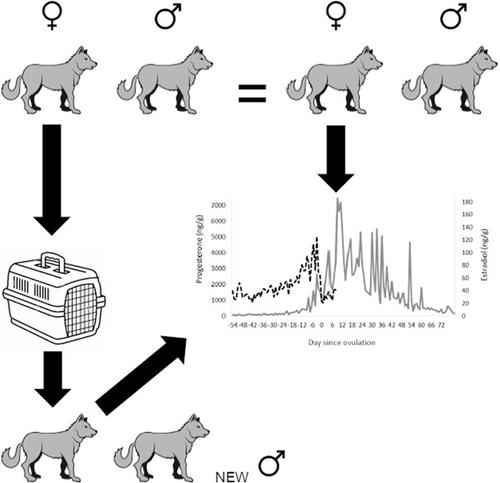Our official English website, www.x-mol.net, welcomes your feedback! (Note: you will need to create a separate account there.)
Estrous cyclicity and reproductive success are unaffected by translocation for the formation of new reproductive pairs in captive red wolves ( Canis rufus )
Zoo Biology ( IF 1.3 ) Pub Date : 2020-05-31 , DOI: 10.1002/zoo.21551 Ashley D Franklin 1, 2 , William T Waddell 1 , Sue Behrns 1 , Karen L Goodrowe 1
Zoo Biology ( IF 1.3 ) Pub Date : 2020-05-31 , DOI: 10.1002/zoo.21551 Ashley D Franklin 1, 2 , William T Waddell 1 , Sue Behrns 1 , Karen L Goodrowe 1
Affiliation

|
This study investigated possible female-related causes for inconsistent success among reproductive pairs in the zoo-based red wolf (Canis rufus) population. Females (n = 13) at seven institutions were assessed for evidence of ovulation and normal reproductive cycles through the measurement of estradiol and progesterone metabolite excretion in feces. Fecal cortisol metabolites (FCM) were also measured. Factors potentially affecting FCM and/or estrous cyclicity were recorded, including exhibit status (on vs. off), reproductive history (proven vs. unproven), copulatory behaviors (ties observed: yes or no), pregnancy/parturition (pups or no pups produced), and translocation before the observed breeding season (yes or no). No differences were observed in baseline FCM between females housed on versus off-exhibit (p = .46) or between females producing pups and those who did not (p = .19). Baseline FCM were significantly lower among females observed in copulatory ties compared to females never observed in a tie (p = .04), and tended to be higher in females translocated before the breeding season compared to females in existing reproductive pairs (p = .11), and among historically unproven females compared to proven females (p = .11). All females evaluated had an endocrine profile indicative of ovulation and among the four females translocated to be paired with a new male before the breeding season, two had successful pregnancies, producing litters. Therefore, despite observed differences in baseline FCM among factors, estrous cyclicity and reproductive success are unaffected by translocation for the formation of new reproductive pairs in the zoo-based red wolf population.
中文翻译:

发情周期和繁殖成功不受圈养红狼(Canis rufus)中新繁殖对形成易位的影响。
这项研究调查了在基于动物园的红狼 (Canis rufus) 种群中,繁殖对成功不一致的可能与女性相关的原因。通过测量粪便中雌二醇和孕酮代谢物的排泄量,评估了七个机构的女性(n = 13)的排卵和正常生殖周期的证据。还测量了粪便皮质醇代谢物 (FCM)。记录了可能影响 FCM 和/或发情周期的因素,包括表现状态(开启与关闭)、生殖史(已证实与未证实)、交配行为(观察到的关系:是或否)、怀孕/分娩(幼崽或无幼崽)生产),并在观察到的繁殖季节之前易位(是或否)。饲养和不饲养的雌性在基线 FCM 中没有观察到差异(p = . 46) 或产仔的雌性和不产仔的雌性之间 (p = .19)。与从未在交配中观察到的雌性相比,在交配关系中观察到的雌性的基线 FCM 显着较低 (p = .04),并且在繁殖季节之前易位的雌性与现有繁殖对中的雌性相比,其基线 FCM 往往更高 (p = .11 ),以及历史上未经证实的女性与已证实的女性相比 (p = .11)。所有受评估的雌性都有一个指示排卵的内分泌特征,在繁殖季节之前易位与新雄性配对的四只雌性中,有两只成功怀孕,产仔。因此,尽管观察到不同因素间基线 FCM 存在差异,
更新日期:2020-05-31
中文翻译:

发情周期和繁殖成功不受圈养红狼(Canis rufus)中新繁殖对形成易位的影响。
这项研究调查了在基于动物园的红狼 (Canis rufus) 种群中,繁殖对成功不一致的可能与女性相关的原因。通过测量粪便中雌二醇和孕酮代谢物的排泄量,评估了七个机构的女性(n = 13)的排卵和正常生殖周期的证据。还测量了粪便皮质醇代谢物 (FCM)。记录了可能影响 FCM 和/或发情周期的因素,包括表现状态(开启与关闭)、生殖史(已证实与未证实)、交配行为(观察到的关系:是或否)、怀孕/分娩(幼崽或无幼崽)生产),并在观察到的繁殖季节之前易位(是或否)。饲养和不饲养的雌性在基线 FCM 中没有观察到差异(p = . 46) 或产仔的雌性和不产仔的雌性之间 (p = .19)。与从未在交配中观察到的雌性相比,在交配关系中观察到的雌性的基线 FCM 显着较低 (p = .04),并且在繁殖季节之前易位的雌性与现有繁殖对中的雌性相比,其基线 FCM 往往更高 (p = .11 ),以及历史上未经证实的女性与已证实的女性相比 (p = .11)。所有受评估的雌性都有一个指示排卵的内分泌特征,在繁殖季节之前易位与新雄性配对的四只雌性中,有两只成功怀孕,产仔。因此,尽管观察到不同因素间基线 FCM 存在差异,



























 京公网安备 11010802027423号
京公网安备 11010802027423号